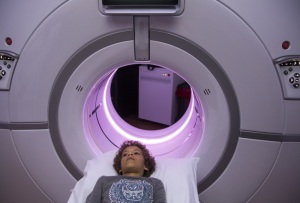by
John R. Fischer, Senior Reporter | October 22, 2018

Dr. Donald Frush says along with
technology, techniques for preparing
patients for scans are essential for
dose optimization.
(Credit: DukeHealth)
From the October 2018 issue of HealthCare Business News magazine
Over the last several years, Duke University Medical Center’s monitoring program for CT performance has undergone some big advancements. These included incorporating CT study image quality metrics to augment the more standard radiation dose profile of each examination, with monitoring of performance by a multidisciplinary team on a regular basis. From creating a set schedule for dose monitoring reviews to organizing accounting and database protocols, the North Carolina institution has taken steps to enhance its program.
“Several years ago, discussions on dose monitoring practices were on a random basis. It would be primarily through protocol review which we tried to do regularly to see that the doses we were delivering were reasonable, but the benchmarks weren’t well developed,” Dr. Donald Frush, a professor of radiology and pediatrics in Duke’s department of radiology, told HCB News. “The development of that formal program has allowed us better data to begin to address what we do and how to improve our service.”
Today, staff members meet quarterly for reviews, searching for outliers to identify areas in need of improvement and formulating approaches to make those fixes. Accounting and database protocols are also in check thanks to the introduction of a server.



Ad Statistics
Times Displayed: 172722
Times Visited: 3125 For those who need to move fast and expand clinical capabilities -- and would love new equipment -- the uCT 550 Advance offers a new fully configured 80-slice CT in up to 2 weeks with routine maintenance and parts and Software Upgrades for Life™ included.
Experts like Frush have witnessed similar transformations across the country in radiation dose management through the introduction of updated guidelines, assessment programs, accreditation, and technological innovations to ensure patients remain safe and receive appropriate amounts of radiation to address their individual imaging needs.
But dose optimization goes deeper than just understanding how radiation management works. It requires a broader knowledge of CT and its usage, from technique to scan prep time, to knowing when a CT scan is or is not the right thing to do.
Dose rates are safe? Prove it.
Almost every facility with a CT scanner today requires some form of accreditation in order to gain reimbursement for exams. In addition to most, if not all, payors, even states are now demanding some form of credentials from providers to demonstrate the safety of their environment and practices.
Obtaining certification varies by accrediting organization, with each requiring facilities to meet certain criteria. The Intersocietal Accreditation Commission (IAC) for instance requires facilities to have a consistent quality assessment program to ensure that periodic random checks of patient radiation exposure rates take place and to review and compare actual patient radiation dose to predetermined doses to avoid overexposure or assess what factors led to it taking place.

